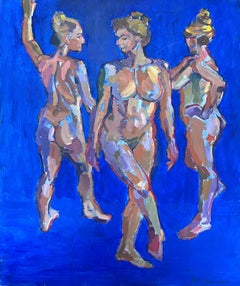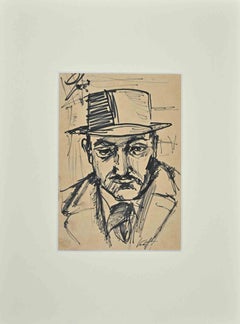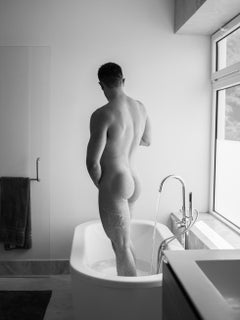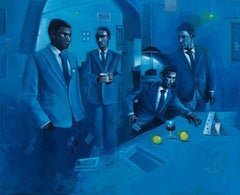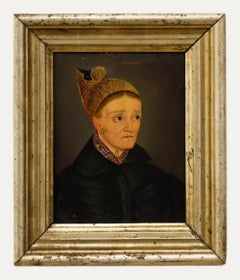Men Art
to
6,553
20,962
10,379
6,947
5,256
6,103
Overall Width
to
Overall Height
to
1,565
4,254
27,601
16,448
390
591
1,168
1,630
1,219
2,631
4,115
3,932
2,958
1,749
902
13,347
11,246
1,905
1,732
987
933
779
699
506
502
357
235
157
75
26,388
16,892
3,614
150,625
78,561
49,947
42,226
36,024
34,521
29,675
26,186
26,162
24,201
20,246
17,143
15,860
14,786
13,602
13,109
10,862
10,285
10,161
8,393
14,062
9,983
8,461
5,938
5,506
2,017
763
366
230
220
8,696
15,836
24,682
20,145
Art Subject: Men
Three Nude Ladies Large British Modernist Contemporary Oil Painting
Located in Cirencester, Gloucestershire
Three Nudes
by Helen Greenfield (British 20th century)
signed oil painting on board, unframed
board: 30 x 25 inches
condition: overall very good
prove...
Category
20th Century Impressionist Nude Paintings
Materials
Oil
Portrait - Original Pen Drawing by Georges Vernotte - 1950s
Located in Roma, IT
Portrait is an original pen drawing realized by Georges Vernotte.
Good condition on yellowed paper.
Hand-signed by the artist on the lower right corner.
Category
1950s Modern Portrait Drawings and Watercolors
Materials
Pen
Italian Early 17th Century Renaissance Baroque Oil Painting Entombment of Christ
Located in Portland, OR
An important & large Italian Baroque period oil painting on panel attributed to Daniele Crespi (1598-1630), "The Entombment of Christ", Milan circa 1620. See artist biography below.
...
Category
1620s Baroque Paintings
Materials
Oil, Panel
Untitled (Jackson)
Located in New York, NY
Untitled (Jackson)
Puerto Vallarta, Mexico
2017-2020
Signed and numbered, verso
Archival pigment print
28 x 22 inches, sheet
24 x 20 inches, image
(Edition of 7)
$2,500
16 x 12.6...
Category
2010s Contemporary Photography
Materials
Archival Pigment
Injured (The Stoic Men) - 21st Century, Contemporary, Figurative, People, Blue
Located in Ibadan, Oyo
Certain tragedies are too profound for us to recover from, not due to a loss of hope, but because the process of healing would necessitate the expulsion of an ineffable beauty from o...
Category
21st Century and Contemporary Contemporary Figurative Paintings
Materials
Canvas, Oil
Folk 19th Century Oil - Portrait of a Styrian Woman
Located in Corsham, GB
A fine folk portrait depicting an Austrian woman in traditional Styrian region attire. She sports a tall, beaded headdress typically seen in Styrian folk wear with a complementary co...
Category
19th Century Portrait Paintings
Materials
Oil
Cafe Terrace In Nice Slim Aarons Estate Stamped Print
By Slim Aarons
Located in London, GB
Cafe Terrace In Nice
1957
by Slim Aarons
Slim Aarons Limited Estate Edition
Holidaymakers on a cafe terrace in Nice on the French Riviera, 1957.
unfra...
Category
1950s Modern Color Photography
Materials
Archival Pigment
Commissionaire's Dog - Black and White Monochrome Print, Getty Archive
Located in Brighton, GB
Taken from the world’s largest photographic archive, (Hulton Archive and Getty Images), the Getty Images Gallery collection features an extraordinary time capsule of the last century...
Category
20th Century Modern Black and White Photography
Materials
Photographic Paper, Black and White
I’d Rather Have a Live Woman than a Frozen Leopard by Julian Schnabel
Located in Long Island City, NY
I’d Rather Have a Live Woman than a Frozen Leopard by Julian Schnabel, American (1951)
Date: 1990
Screenprint, signed and numbered in pencil
Edition of 16/60
Size: 35.5 x 28.5 in. (9...
Category
1990s Contemporary Portrait Prints
Materials
Screen
Outbreak V
Located in Palm Springs, CA
Medium: Mezzotint
Image size: 7 x 5 inches
Sheet size is 11 x 15 inches
Edition of 50
This print is from the Blood Bone Elegy, a suite of eighteen color mezzotints depicting the out...
Category
21st Century and Contemporary Contemporary Figurative Prints
Materials
Mezzotint
Self Portrait, Drawing at the Window
Located in San Francisco, CA
Artist: Rembrandt Van Rijn (Dutch, 1606-1669)
Title: Self Portrait, Drawing at the Window
Year: 1648
Medium: Etching
Paper: Verge paper
Image (plate mark) size: 6.35 x 5.25 inch...
Category
Mid-17th Century Old Masters Figurative Prints
Materials
Etching
Bathers - Nude Figures in Landscape Oil by Paul Gustav Fischer
By Paul Gustave Fischer
Located in Marlow, Buckinghamshire
Signed and dated oil on canvas nudes in seascape by Danish realist painter Paul Gustav Fischer. The work depicts two young women bathing on a rocky shoreline looking our towards the ...
Category
1920s Realist Nude Paintings
Materials
Oil, Canvas
Large Antique German Oil Canvas Hermann Frobenius Pre-Raphaelite Painting 1900
Located in Portland, OR
A Large and impressive antique oil on canvas Pre-Raphaelite painting by the German artist, Hermann Frobenius (1871-1954), signed and dated 1900.
Frobenius had classical training and studied both in Rome and Florence, he later was in the circle of Arnold Bocklin and Hans von Marees, he settle in Munich but also in Dresden briefly and latterly in Berlin. He, like many other European painters was fascinated with North Africa and painted many oriental scenes of Algiers, Tunis and Cairo, he was represented at many exhibitions, including the "Great German Art Exhibition" in Munich 1941.
This painting (an early example of the artist's work) is very finely painted in the Pre Raphaelite style, depicting a medieval costumed...
Category
Early 1900s Pre-Raphaelite Figurative Paintings
Materials
Canvas, Oil
Self Portrait, Post-Modern Lithograph by Norman Rockwell
Located in Long Island City, NY
Norman Rockwell, American (1894 - 1978) - Self Portrait, Medium: Lithograph on Japon paper, numbered in pencil and plate signed, Edition: AP, Size: 22 x 21 in. (55.88 x 53.34 cm), Fr...
Category
Early 20th Century Post-Modern Prints and Multiples
Materials
Lithograph
Edward Hopper 'Conference at Night' 1993- Offset Lithograph
Located in Brooklyn, NY
Immerse yourself in the rich tapestry of 20th-century American art with this page from "American Art in the 20th Century," a 1993 portfolio by Te Neus Verlag, printed in Germany. Thi...
Category
1990s Prints and Multiples
Materials
Offset
Anonymous Male Nude Dancer
Located in Senoia, GA
11 x 14" vintage silver gelatin photograph of anonymous male dancer, 1965. Comes directly from the Jack Mitchell Archives with a certificate of authenticity.
Jack Mitchell, (1925-...
Category
1970s Pop Art Black and White Photography
Materials
Silver Gelatin
$1,200 Sale Price
20% Off
The Lamp : Evening Work - Original Lithograph - 1898
Located in Paris, IDF
Francois GUIGUET
The Lamp : Evening Work , 1898
Original lithograph (Champenois workshop)
Printed signature in the plate
On vellum, 40 x 31 cm (c. 16 x 12 in)
INFORMATION: Lithogra...
Category
1890s Art Nouveau Nude Prints
Materials
Lithograph
original lithograph
By Raoul Ubac
Located in Henderson, NV
Medium: original lithograph. Printed in 1972 for the art revue Derriere le Miroir (issue number 196) and published in Paris by Maeght. Size: 15 x 11 inches (378 x 276 mm). Not signed.
Category
1970s Prints and Multiples
Materials
Lithograph
Jayne Mansfield with Seagrams Dogs (Limited Edition of 10, No 6-10) - 30"x40"
By Barry Kramer
Located in New York, NY
Shot by Barry Kramer (1921- 1984), one of the most prolific photographers of his time, captures the essence of 1950's Hollywood movie star, Jane Mansfield...
Category
1950s Contemporary Photography
Materials
Archival Pigment
Fine 19th Century French Realist Oil Painting Chef in Kitchen Pantry Larder
Located in Cirencester, Gloucestershire
Le Chef
circle of Théodule-Augustin Ribot (French, 1823 – 1891)
oil on board, framed
framed: 20.5 x 16.5 inches
board: 15 x 12 inches
inscribed verso
provenance: private collection, ...
Category
19th Century Realist Figurative Paintings
Materials
Oil
American Painting Native American Dance Exhibition New Mexico Antelope Dancers
Located in Buffalo, NY
An original oil painting by American artist Rudolph Wedow. This fantastic painting depicts Antelope Dancers in San Felipe Pueblo in New Mexico.
Created...
Category
1940s American Impressionist Figurative Paintings
Materials
Oil, Board
Trisha Brown and Lance Grier performing 'Set and Reset', signed by Jack Mitchell
Located in Senoia, GA
11 x 14" vintage silver gelatin photograph of Trisha Brown and Lance Grier performing 'Set and Reset', 1987. Signed by Jack Mitchell on the print verso. C...
Category
1980s Pop Art Black and White Photography
Materials
Silver Gelatin
1880's French Impressionist Oil Painting Portrait Ambroise Vollard Famous Dealer
Located in Cirencester, Gloucestershire
Portrait believed to be of Ambroise Vollard
by Adolphe GUMERY (1861-1943)
oil painting on canvas stuck on board, unframed
faintly signed & dated 1883
board: 10 x 8.5 inches
condition...
Category
Late 20th Century Impressionist Portrait Paintings
Materials
Oil
Renew - 21st Century, Contemporary, Figurative Portrait, Children Art, Jewellery
Located in Ibadan, Oyo
Shipping Procedure
Ships in a well-protected tube from Nigeria
This work is unique, not a print or other type of copy.
Accompanied by a Certificate of Authenticity (Issued by the Gal...
Category
21st Century and Contemporary Expressionist Portrait Paintings
Materials
Canvas, Acrylic
$2,680 Sale Price
20% Off
At the Museum I - surreal, contemporary, figurative, oil on canvas
Located in Bloomfield, ON
This surrealist painting by Toni Hamel features a Group of Seven piece and focuses on the theme of climate change.
In this imaginative painting, Toni Hamel sends a powerful message ...
Category
2010s Surrealist Figurative Paintings
Materials
Canvas, Oil
Edward, My Son (with Deborah Kerr) (20% OFF LIST PRICE)
Located in Kansas City, MO
Spencer Tracy & Deborah Kerr
Edward, My Son
Black & White Photograph on Photographic Paper
Year: 1949
Size: 6.5 x 8 inches (16.51 x 20.32 cm)
Stamped verso
Publisher: Metro-Goldwyn-...
Category
1940s Modern Portrait Photography
Materials
Photographic Paper, Silver Gelatin
$88 Sale Price
20% Off
Sophia Loren Shooting Pool
Located in Austin, TX
A Vintage 1958 Photograph featuring Italian actress Sophia Loren showing her skills in billiards as captured by the Italian photo agency Liverani of Rome during a private shoot.
Sop...
Category
1950s Contemporary Black and White Photography
Materials
Archival Ink, Archival Paper, Archival Pigment
The Martyrdom Of Saint Barbara, 17th Century SCHOOL OF GUERCINO (1581-1666)
By Giovanni Francesco Barbieri (Il Guercino)
Located in Blackwater, GB
The Martyrdom Of Saint Barbara, 17th Century
SCHOOL OF GUERCINO (1581-1666)
Large 17th Century Italian Old Master of the Martyrdom of St Barbara, oil on canvas. After being impriso...
Category
17th Century Portrait Paintings
Materials
Canvas, Oil
$5,426 Sale Price
35% Off
The Lower Ridding - Etching by Joseph Banks - 1837
Located in Roma, IT
The Lower Ridding is an artwork, realized by the artist Joseph Banks in 1837.
Colore etching, titled and signed in the plate.
Beautiful engraving with contemporary colouring. Editi...
Category
1830s Modern Figurative Prints
Materials
Etching
Soft Rock : Sleeping Model on Red Background - Original Handsigned Painting
Located in Paris, IDF
Claude GAVEAU
Soft Rock : Sleeping Model on Red Background
Original gouache painting
Handsigned in ink
On thick paper 50 x 65 cm (c. 19.6 x 25.5 inch)
Very good condition
Category
Late 20th Century Modern Nude Drawings and Watercolors
Materials
Gouache
"Grandfather and grandson" Oil cm.140 x 122 , 1996
Located in Torino, IT
Grandfather, Grandson, Countryside, summer, child, dog,impressionist
Published in a monographic catalogue
Georgij MOROZ (Dneprodzerzinsk, Ucraina, 1937 - St. Petersburg, 2015)
193...
Category
1990s Impressionist Figurative Paintings
Materials
Oil
$14,675 Sale Price
30% Off
A las armas (To arms) is a poster of the Cuban revolution against the USA
Located in PARIS, FR
A las armas (To arms) is a poster of the Cuban revolution against the USA.
Kalashnikov in hand and ready to fight to defend the revolution. The Commun...
Category
1970s Prints and Multiples
Materials
Lithograph, Paper
Woman - XXI century Contemporary figurative bronze sculpture, Classical, Realism
Located in Warsaw, PL
RYSZARD PIOTROWSKI (born in 1952) Sculptor. He graduated from the Academy of Fine Arts in Warsaw. His works include intimate, small forms in marble, bronze and silver. He specializes...
Category
21st Century and Contemporary Contemporary Figurative Sculptures
Materials
Marble, Bronze
I adore your boogies-woogies. Figurative painting with popular dancers and music
By Igor Fomin
Located in Segovia, ES
I love your “Boogies-woogies”, (Adoro tus "Bugisvugis"). Figurative painting with popular dancers and musicians.
Acrylic on canvas.
Measurements in centimeters: 97 x 130 x 3 cm. Fram...
Category
Early 2000s Modern Figurative Paintings
Materials
Canvas, Acrylic
$13,883 Sale Price
20% Off
Remembering a Great Love - Contemporary, Fire, Prometheus, Couple, Nude, Myth
Located in Baden-Baden, DE
Remembering a Great Love, 2019
Acrylic on canvas
82 43/64 H x 94 31/64 W in.
210 H x 240 W cm
"Remembering a Great Love" is a reinterpretation of the fundamental myth of Pygmalion. ...
Category
2010s Contemporary Figurative Paintings
Materials
Canvas, Acrylic
Orientalist North African Figures Market Stall City Scene large Oil Painting
Located in Cirencester, Gloucestershire
Market Stall Conversation
French School, 20th century
oil on canvas, unframed
canvas : 24 x 20 inches
provenance: private collection, France
condition: sound condition but with consi...
Category
Mid-20th Century French School Figurative Paintings
Materials
Oil, Canvas
1900's Alabaster Sculpture of Dante
Located in Los Angeles, CA
A sensitively carved, solid alabaster, antique sculpture of famed Italian poet and philospher, Dante Aligheri (1265-1321). The figure in a rich, flowing robe, holding a book and wear...
Category
1910s Figurative Sculptures
Materials
Alabaster, Marble
Crab Food, Painting, Acrylic on Paper
Located in Yardley, PA
A 16X20 inch acrylic on canvas paper painting of a giant crab chasing a crab meat vendor on the beach. Who is the food? :: Painting :: Contemporary :: This ...
Category
2010s Contemporary Paintings
Materials
Acrylic
Telengana Pandit, Acrylic on Canvas by Modern Artist Thota Vaikuntam "In Stock"
By Thota Vaikuntam
Located in Kolkata, West Bengal
Thota Vaikuntam - Telengana Pandit
Acrylic on Canvas, 23 x 17.75 inches
Thota Vaikuntam is one of the Greatest Artist from the Indian Sub-contitent. He is preoccupied with portraying the men and woman from his region.
Thota Vaikuntam (born 1942) is an Indian Modern painter.His paintings capture simple lifestyle of villagers like the paddy fields, toddy pots on shoulders of men, the household chores, temple rituals etc. His drawings range from stark charcoal on paper, transparent washes and pencil drawings.
Vaikuntam paints colorful and elaborately dressed Telangana region men and seductive women. His muse is the sensuous and voluptuous women of Telangana with their omnipresent vermilion bindis, draped in colourful sarees that highlight their dusky skin.
The stylisation of a painting are a perfect foil to Indian classical dance as the figures seem to dance, as if following their creator in a statuesque movement, reminiscent of temple friezes. He uses the brightest of reds and yellows. The simple women become larger than life as they fill the small format of his paintings draped in bright Sircilla saris.
"I like using rich primary colours, which give a sense of character and depth to my paintings. Like reds and saffron and even orange, because these are essentially Indian colours. I don't like using colours that are mix of two, because they are not natural, they don't exist in surroundings around us, in our everyday life. - T. Vaikuntam”
Style : Men and women of his village are often the central characters of his work. The obsession can be traced back to his childhood, when he used to be fascinated by the male artists who used to impersonate female characters in the travelling theatre groups that performed in his village. He admits finding the women of his village very sensuous and that he only attempts to capture their vibrancy. Vaikuntam’s art has a sense of strength to it, a power that emanates from the paint or charcoal that he applies to the surface, from his controlled lines, and from the fine strokes that he executes. He generally uses only primary colours, as he believes that composite colours do not exist in nature and are therefore, unnatural.
About the Artist :
Born : 1942 in Boorugupali, Andhra Pradesh.
Education :
1970 - T. Vaikuntam completed a Diploma in Painting at the College of Fine Arts and Architecture, Hyderabad.
1972 - Painting and Printmaking from the Faculty of Fine Arts at Maharaja Sayajirao University, Baroda.
Solo Exhibition :
1973 - He held his first solo exhibition at the Kala Bhavan in Hyderabad and since then has had regular shows...
Category
2010s Modern Figurative Paintings
Materials
Canvas, Acrylic
Against the Glass
Located in London, GB
Alkyd-oil on Masonite board, 102cm x 83cm, (124cm x 104cm framed). The painting comes directly from the artist.
Michael Leonard is most probably most famous for his portrait of HM ...
Category
Early 2000s Post-War Figurative Paintings
Materials
Masonite, Alkyd
Stage design of Mausoleum. Entourage Galli Bibbiena.
Located in Firenze, IT
The Galli Bibiena Dynasty and European Courts.
The Galli Bibiena family, renowned Italian artists and scenographers, served the most distinguished European courts, including those ...
Category
18th Century Baroque Interior Drawings and Watercolors
Materials
Paper, Ink
$749 Sale Price
32% Off
The Basket Dancers Bronze Sculpture Statue Young Native Pueblo Women New Mexico
Located in Portland, OR
A fine & large bronze sculpture "Basket Dancers", by the celebrated American sculptor Glenna Goodacre (1939-2020).
A beautiful and sensitively rendered bronze sculptural group depict...
Category
1970s American Realist Figurative Sculptures
Materials
Bronze
The Strokes
Located in Austin, TX
Signed limited edition print of The Strokes by acclaimed British photographer, Andrew Cotterill.
“This was one of my early shoots for Dazed and Confused m...
Category
21st Century and Contemporary Contemporary Portrait Photography
Materials
Archival Pigment
Clyde
Located in New York, NY
Archival pigment print, painted frame (Edition of 4 + 1 AP)
Signed and numbered, verso
This photograph is offered by ClampArt, located in New York City.
Price includes mounting and ...
Category
2010s Contemporary Portrait Photography
Materials
Archival Pigment
$3,600
French School 19th Century Oil - A Day in the Park
Located in Corsham, GB
A charming French school scene depicting figures in 18th-century dress lounging in a sunlit park. Unsigned. Presented in a gilt frame with acanthus detail. On canvas.
Category
19th Century Figurative Paintings
Materials
Oil
Henry Raeburn, (circle) 19th Century portrait of Sir Charles Forbes Edinglassie
By Henry Raeburn (circle)
Located in York, GB
Portrait of Sir Charles Forbes of Edinglassie, Oil on canvas.
The size of the portrait is 75 cm x 59.5 cm whilst overall the size is 106 cm x 91 cm
In very good condition.There has been some restoration/overpainting etc.There is some minor craquelure.
Housed in a period gilt frame decorated with acorns and leaves
Overall a good portrait, circle of a fine scottish artist , with an interesting sitter, his details below.
sir Charles Forbes of Edinglassie
Sir Charles Forbes, 1st Baronet (1774–1849) was a Scottish politician, of Newe and Edinglassie, Aberdeenshire. Forbes was the son of the Rev. George Forbes of Lochell. He was a descendant of Alexander Forbes of Kinaldie and Pitsligo, and was in 1833 served heir male in general to Alexander Forbes, 3rd lord Forbes of Pitsligo, father of Alexander Forbes, 4th Lord Forbes of Pitsligo, attainted in 1745.
Forbes was of a bluff but kindly nature, diffident as to his own merits, of a straightforward and manly character. On the death of his uncle in 1821 Forbes succeeded to the entailed estates of the Forbeses of Newe, and was created a baronet by patent in 1823.[1] He married in 1811. His daughter, Elizabeth, married General, Lord James Hay, second son of the seventh Marquess of Tweeddale.
Sir Henry Raeburn FRSE, RA, RSA (1756-1823)
Scottish portrait painter and Scotland's first significant portrait painter
since the Union to remain based in Scotland.
He served as Portrait Painter to King George IV in Scotland
Raeburn had all the essential qualities of a popular and successful portrait painter.
He was able to produce a telling and forcible likeness;
his work is distinguished by powerful characterisation,
stark realism, dramatic and unusual lighting...
Category
19th Century Old Masters Portrait Paintings
Materials
Oil
$5,379 Sale Price
33% Off
After Bartolomeo Schedoni - 19th Century Oil, Study of a Boy from 'The Charity'
Located in Corsham, GB
After Bartolomeo Schedoni (1578-1615). Italian School, Portrait study of a boy from the 1611 painting 'The Charity'. Oil on canvas. Well presented in a gilt effect frame with lambs t...
Category
19th Century Portrait Paintings
Materials
Oil
Michael Standing
By Peter Brooke
Located in Pasadena, CA
Provenance
Acquired by the gallery directly from the artist
EXHIBITIONS
California Art Clubs 95th Annual Gold Medal Juried Exhibition
April 2 - 23...
Category
Early 2000s Realist Figurative Sculptures
Materials
Bronze
Flower Still Life, Impressionist Oil Painting by Thomas Strickland
Located in Long Island City, NY
Artist: Thomas Strickland, American (1923 - 1999)
Title: Flower Still Life
Year: circa 1960
Medium: Oil on Canvas, signed u.l.
Size: 20 x 24 inches
Frame: 31 x 27.5 inches
Category
1960s American Impressionist Still-life Paintings
Materials
Oil, Canvas
Dancer VIII- 21st Century Bronze Sculpture of a Male Nude Dancing
Located in Nuenen, Noord Brabant
This sculpture is made out of bronze, by Dutch artist Martijn Soontiens.
His male dancing sculptures are about moving and movement. Artist Martijn Soontiens creates special atmospheres with his special bronze male sculptures. His images, from small to life-sized, show bodies in positions and movements that are and remain exciting while you look at them.
The artist himself says about this: "I look for balance, excitement and vitality in my sculptures. I have focused on making bronze sculptures. Human figures...
Category
2010s Contemporary Figurative Sculptures
Materials
Bronze
Original Vintage Poster by Alphons Mucha Flirt for Biscuits Lefevre Utile 1900
Located in Boca Raton, FL
This enchanting Art Nouveau poster by Alphonse Mucha was created in 1899 to promote Lefèvre-Utile biscuits, one of the premier French biscuit makers of the era. In "Flirt," Mucha tra...
Category
Early 1900s Prints and Multiples
Materials
Lithograph
Pantomime : Harlequin and Pierrot - Original Lithograph, 1898
Located in Paris, IDF
Henri Gabriel IBELS
Pantomime : Harlequin and Pierrot, 1898
Original lithograph (Champenois workshop)
Printed signature in the plate
On vellum, 40 x 31 cm (c. 16 x 12 in)
INFORMATI...
Category
1890s Art Nouveau Figurative Prints
Materials
Lithograph
Mid 19th Century French Signed Portrait of Gentleman with Letter & Quill Pen
Located in Cirencester, Gloucestershire
Portrait of a Gentleman
French School, mid 19th century
signed to the letter and dated
oil on canvas, framed
framed: 36 x 28 inches
canvas: 29 x 20 inches
Provenance: private collect...
Category
Mid-19th Century French School Portrait Paintings
Materials
Oil
Alex Katz Private Domain 1970 (announcement card)
By Alex Katz
Located in NEW YORK, NY
Alex Katz “Private Domain” announcement card 1970:
Rare vintage Alex Katz announcement card published on the occasion of 'Alex Katz New Paintings' Fi...
Category
1970s Pop Art Prints and Multiples
Materials
Lithograph, Offset
'Reclining Nude', Paris, Louvre, Salons d'Automne et Chaumière, LACMA, SFAA
Located in Santa Cruz, CA
Painted circa 1955 by Victor Di Gesu (American, 1914-1988) and stamped verso with Victor di Gesu estate stamp.
Winner of the Prix Othon Friesz, Victor di Gesu first attended the Los...
Category
1950s Post-Impressionist Figurative Paintings
Materials
Oil, Rice Paper
Duke Ellington Jazz Music Legend African American Grammys NY Times Published
Located in New York, NY
Duke Ellington Jazz Music Legend African American Grammys NY Times Published
Al Hirschfeld (1903 – 2003)
Duke Ellington
Sight Size: 12 x 12 1/4 inches
Etching with aquatint
Signed ...
Category
1990s Performance Figurative Prints
Materials
Lithograph
Slim Aarons, C Z & Friends in a Model T, Palm Beach (Slim Aarons Estate Edition)
By Slim Aarons
Located in Los Angeles, CA
American stage actress, author, columnist, horsewoman, fashion designer, and socialite, C. Z. Guest, ( aka Mrs. Winston F. C. Guest, 1920 - 2003) with her personalized Ford Model T t...
Category
1960s American Realist Portrait Photography
Materials
Lambda
Portrait of Ship Captain George Buckman
Located in Milford, NH
A fine oil on canvas portrait of Captain George Buckman, identified lower center, indiscernibly signed and dated 1860 lower right, with a tall ship with an American flag in the backg...
Category
1860s Portrait Paintings
Materials
Canvas, Oil
Reflections in the Twilight Oil Painting on Canvas Girls Guardian Angel In Stock
Located in Utrecht, NL
Reflections in the Twilight Oil Painting on Canvas Girls Guardian Angel In Stock
Introduction: Step into the intriguing world of artist Suzan Schuttelaar and be enchanted by her vers...
Category
21st Century and Contemporary Contemporary Figurative Paintings
Materials
Canvas, Oil
"Archie" - Acrylic on Canvas
Located in West Hollywood, CA
Melinda has studied life and its movements, developing a remarkably keen artistic technique with her flowing expressionistic style. Growing up in the Midwest she was enamored with n...
Category
2010s Pop Art Animal Paintings
Materials
Canvas, Acrylic
